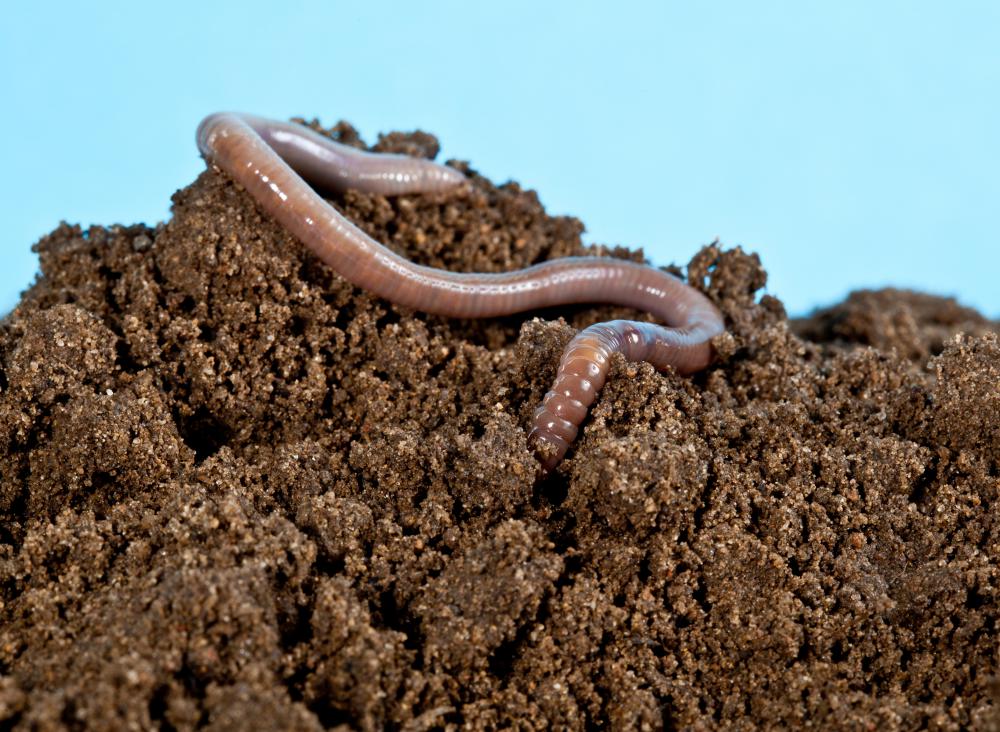At HomeQuestionsAnswered, we're committed to delivering accurate, trustworthy information. Our expert-authored content is rigorously fact-checked and sourced from credible authorities. Discover how we uphold the highest standards in providing you with reliable knowledge.
What is Eisenia Fetida?
Eisenia fetida is a species of earthworm found in many regions of the world. These worms are often raised by people in a process known as vermiculture and sold for use by fishermen and gardeners. Common names for Eisenia fetida include redworm, brandling worm, tiger worm, and red wiggler room. As some of these common names imply, Eisenia fetida has a reddish body marked with horizontal stripes which run along the segments of its body.
Like other earthworms, Eisenia fetida is classified as an annelid worm, meaning that its body is broken up into a large number of segments. This worm is also hermaphroditic, possessing both male and female traits. Earthworms reproduce by joining up with another earthworm and exchanging sperm with the other worm for the purpose of fertilizing eggs. This often occurs near the soil surface, and people can sometimes spot earthworms, including Eisenia fetida, swapping genetic material.

The “fetida” in this worm's scientific name, which used to be spelled “foetida,” references the fact that this worm uses a strong smelling secretion as a defense. If the worms are handled roughly, they will emit a distinctive odor which is designed to drive away predators. This stinky secretion can also be used to differentiate between Eisenia fetida and some close relatives which look and behave in similar ways.

Eisenia fetida is an epigeic worm species, preferring to live near the surface of the soil, rather than burrowing into it. The ideal habitat for these worms is a deep litter of decaying organic material, which makes them wonderfully suited to vermicomposting. Gardeners can introduce Eisenia fetida to their compost with the goal of encouraging the worms to break down the compost, and if the worms are happy, they will breed and perpetuate the worm population, maintaining a steady supply of worms to work in the compost bin. These worms are tolerant of temperature fluctuations, making them suitable for many climates.
In addition to being used in composting, Eisenia fetida is also used as a bait worm. Fisherman sometimes seek out these worms because they can live longer underwater than other worm species, presenting an appealing target to fish as they wriggle at the end of a bait hook. The worms are also easy to handle and transport, making them convenient for fishing trips.
People who are interested in purchasing these worms can sometimes find them at gardening supply or fishing supply stores. The worms can also be ordered in bulk through catalogs or Internet retailers.
AS FEATURED ON:
AS FEATURED ON:












Discussion Comments
@Tomislav - No, earthworms do not have feelings, according to a recent Norway study on animals that have a simple nervous system. So apparently other invertebrates, like lobsters and snails, along with worms, do not have the ability to process emotional information.
Since these animals cannot process emotional information, they can't and don't suffer.
The reason why these animals move in such a way that make some of us think that they have emotions and feel pain is because when we put a worm on a hook it wiggles around a lot.
This is not because the worm feels pain, it is because worms, and other invertebrates, have groups of neurons connected by nerve fibers. When these neurons are stimulated, this causes muscles to contract. The muscle contraction is why worms wiggle around, not because they are feeling any pain.
I think when the author of this article mentioned about the worm being "happy", it was just a figure of speech, not meant literally.
I was sort of grossed out by earthworms as a child, but now that I am older they seem interesting. I didn't know that they help break down the organic compost some gardeners use to make good soil for their garden.
My Dad actually used to use organic compost to make a pretty thriving garden in the backyard, but the neighbors complained of the smell too much, so my Dad just quite gardening because he did not want to do it any other way.
I didn't even think about how earthworms could help us like that. That is cool.
The article says that if the earthworms are happy, they will stay in that area and expand the earthworm population.
This makes me wonder. Do earthworms really have feelings?
Post your comments